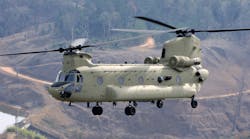The U.S. Army assigned a $4-billion contract to Boeing Defense, Space & Security for 177 CH-47F Chinook helicopters, beginning in 2015. The Army holds options that would allow it to increase its total purchases to 215 helicopters.
The CH-47 Chinook is a twin-engine, tandem rotor heavy-lift helicopter used mainly for troop movement, artillery placement, and battlefield supply. It has the highest weight lifting capacity of all helicopters used by Western military forces. In addition to the U.S. Army, 18 other defense services worldwide have adopted Chinook helicopters for transport, humanitarian, and other tasks. The U.S. Army introduced the Chinook helicopter in 1961, and the current model debuted in 2001.
In its announcement, Boeing noted that the new agreement would save “the U.S. government” more than $800 million: "This multi-year contract provides unprecedented savings for the U.S. Army and American taxpayers," stated Col. Robert Barrie, U.S. Army project manager for Cargo Helicopters. "But, the most important benefit is the continued support these aircraft will provide to soldiers in the field and civilians in distress."
Boeing said the new order eventually would bring the U.S. Army's CH-47F total procurement close to its target of 464 aircraft, including 24 to replace peacetime attrition aircraft. The Army's current inventory stands at 241 F-model aircraft.
There are 15 Army active-duty and National Guard units operating the CH-47F, and a 16th is being equipped.
CH-47F units have logged more than 86,000 combat hours in Afghanistan, maintaining an operational readiness rate of over 80 percent while conducting air assault, transport, and medical evacuation and support missions.
"The Army is benefiting not only from the efficiencies of a multi-year contract but also from the production efficiency gains Boeing and our suppliers have made," said Chuck Dabundo, v.p., Boeing Cargo Helicopter Programs. "That includes the $130-million investment we made to modernize the Chinook factory. This contract will enable Boeing and our partners and suppliers in 45 states to bring stability to the workforce and to invest in production tooling, processes, and other capital improvements."







